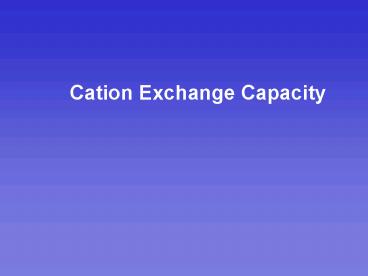Cation Exchange Capacity - PowerPoint PPT Presentation
1 / 7
Title:
Cation Exchange Capacity
Description:
Knowledge of this process can be used to develop appropriate soil treatment. The CEC is important as an indicator for buffering soil against pH acidification. ... – PowerPoint PPT presentation
Number of Views:1109
Avg rating:3.0/5.0
Title: Cation Exchange Capacity
1
Cation Exchange Capacity
2
Soil works like a giant magnet, attracting
cations and repelling anions positively and
negatively charged nutrients. Knowledge of this
process can be used to develop appropriate soil
treatment
The CEC is important as an indicator for
buffering soil against pH acidification. It is
also used as an indication of the soils potential
to hold plant nutrients.
3
CEC is the abbreviation for the cation exchange
capacity of the soil. Any element with a
positive charge is called a cation. For example,
the basic cations, calcium (Ca2), magnesium
(Mg2), potassium (K) and sodium (Na) and the
acidic cations, hydrogen (H) and aluminum
(Al3).
Clay and organic matter in the soil have a
negative charge. So naturally it attracts
positively charged nutrients and repels
negatively charged nutrients. This explains why
cations, the positively charged nutrients, find
an easy home in the soil while anions, negatively
charged nutrients, are repelled and easily
leached out of the soil.
4
Cations and Anions in Soil
5
The amount of these positively charged cations a
soil can hold is described as the CEC and is
expressed in milliequivalents per 100 grams
(meq/100g) of soil. Cations retained
electrostatically are easily exchangeable with
other cations in the soil solution and are thus
readily available for plant uptake. Thus, CEC is
important for maintaining adequate quantities of
plant available calcium (Ca2), magnesium (Mg2)
and potassium (K).
In addition, the higher the CEC, the higher the
buffering capacity of soils to acidification.
6
7
Affect on pH on Cation Exchange Capacity
Of the three factors that have an affect on CEC,
(clay, organic matter and pH) usually only pH can
be changed. Soil pH changes the CEC because the
soil has exchange sites that become active as the
pH increases. Soil CEC could be expected to
increase up to 50 if the pH was changed from 4.0
to 6.5 and nearly double if the pH increased from
4.0 to 8.0.































